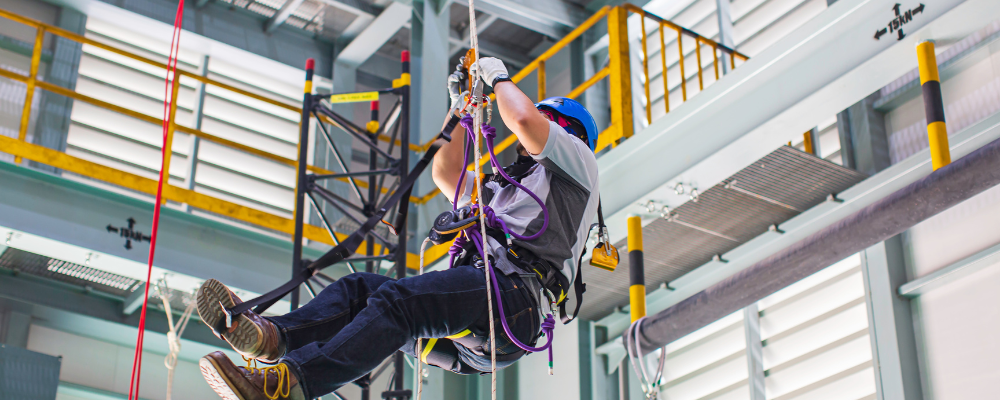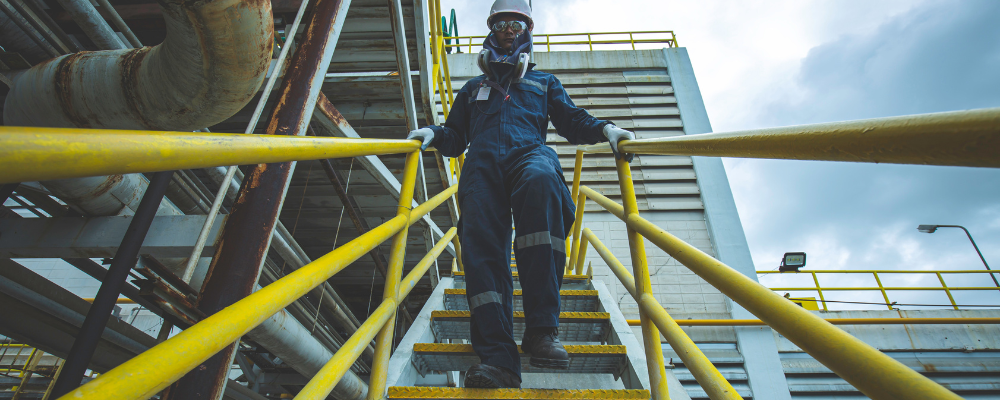Introduction
The construction industry is a field where safety isn’t just a priority—it’s a non-negotiable necessity. In particular, when safeguarding against falls, stringent safety measures are imperative. This comprehensive guide aims to explore the critical elements of fall protection gear essential for the safety of every construction worker.
Understanding the Significance of Fall Protection Hazards Linked to Working at Heights
Understanding the gravity of fall protection is crucial, especially in the context of the inherent risks associated with working at heights. Elevated tasks in construction inherently carry a heightened risk of accidents. Falls are a predominant cause of injuries and fatalities due to various factors:
Gravity-Related Accidents: Elevated work exposes individuals to the risk of severe injuries or even fatalities from falls. The sheer force of gravity amplifies the impact of such accidents.
Surface Instabilities: Unpredictable surfaces, such as scaffolding, rooftops, or uneven terrains, significantly escalate the chances of slipping or tripping, leading to falls.
Objects in Motion: Tools, materials, or machinery maneuvered at heights pose a significant threat. A simple misstep or miscalculation could result in these objects falling and causing severe injuries.
Recognizing these inherent risks underscores the necessity for robust fall protection measures within the construction industry. Without these measures, workers are continually exposed to life-threatening hazards.
Adhering to Regulatory Standards for Fall Protection
Government bodies have instituted stringent safety regulations to mitigate fall-related risks at construction sites. Compliance with these standards isn’t just advisable; it’s imperative for the safety of workers and adherence to legal norms. Some key regulations include:
OSHA Standards: The Occupational Safety and Health Administration (OSHA) outlines comprehensive guidelines covering equipment, training, and safety protocols to prevent falls and mitigate their impact.
ANSI Standards: The American National Standards Institute sets norms that govern the reliability and effectiveness of fall protection equipment, ensuring their adherence to industry standards.
Local Building Codes: Specific guidelines tailored to regional construction requirements serve as additional measures to bolster safety at construction sites.
Understanding and strictly adhering to these regulations isn’t just a matter of compliance; it’s a commitment to safeguarding the lives of those working in the construction industry. These standards serve as a foundational framework for ensuring a safe working environment and minimizing fall-related incidents that can have dire consequences.

Best Practices for Ensuring Fall Protection Thorough Equipment Inspection and Maintenance
Ensuring optimal fall protection through thorough equipment inspection and maintenance is pivotal in safeguarding workers. Implementing best practices in this realm is non-negotiable for optimal functionality and safety. Here’s a detailed note on these practices:
- Scheduled Inspections: Regular and scheduled checks of fall protection gear are vital. These inspections, ideally conducted before each use, aim to identify any signs of wear, tear, or damage. This proactive approach helps prevent accidents resulting from faulty equipment.
- Prompt Maintenance: Addressing any issues identified during inspections promptly is crucial. Timely repairs and maintenance ensure that the gear maintains its integrity and functionality. Ignoring or delaying repairs can compromise worker safety.
- Record-Keeping: Detailed documentation of inspections, repairs, and replacements is essential for accountability and traceability. Maintaining comprehensive records aids in tracking the equipment’s history and making informed decisions regarding replacements or repairs.
Maintaining a well-documented inventory of fall protection gear is indispensable. It mitigates risks and ensures the safety of workers operating at elevated positions.
Additionally, comprehensive training and education are fundamental in reducing fall-related incidents. Properly trained personnel possess the necessary knowledge and skills to use fall protection equipment effectively. Here are key aspects of training:
- Equipment Familiarization: Detailed instruction on correctly using fall protection gear is crucial. Workers must understand how to wear, adjust, and utilize the equipment effectively to ensure safety.
- Safety Procedures: Guidance on safety protocols when working at heights is essential. Emphasis on precautionary measures and emergency response protocols equips workers to navigate potential hazards.
- Regular Refreshers: Continuous education through periodic refresher courses is vital. These sessions reinforce existing knowledge and update workers on the latest safety standards and equipment advancements. This ongoing training ensures workers remain updated and adept in their fall protection practices.
Empowering workers with the necessary knowledge and skills is paramount in preventing falls and maintaining a secure work environment.
Lastly, ensuring access to essential gear for fall protection is critical. This includes equipment like harnesses, ropes, anchors, and limiters, vital for securing workers at elevated positions.
By adhering to these best practices, construction sites can significantly minimize fall-related risks and ensure the safety of their workforce.

Selecting Appropriate Fall Protection Equipment
Factors Influencing Equipment Choice
- Site-specific Requirements: Equipment must be tailored to construction specifics. This involves considering the work’s nature, heights, and environmental conditions.
- Compatibility: Ensuring gear complies with existing safety measures and regulations at the construction site is crucial to maintaining consistency and effectiveness in safety protocols.
- Worker Comfort and Mobility: Balancing safety with ease of movement is essential. The selected gear should not hinder a worker’s ability to perform tasks comfortably and efficiently.
Comparison of Gear Types
- Harnesses vs. Belts: Understanding the advantages of harnesses and belts for various job requirements. While harnesses provide full-body support, belts may be more suitable for specific tasks.
- Anchor System Suitability: Exploring different anchor systems based on site specifics, including the structure, height, and nature of work.
Importance of Sizing and Fitting
Ensuring proper sizing for individual workers maximizes safety by ensuring a snug fit and optimal equipment functionality.
Maintenance and Inspection Protocols
Guidelines for Regular Inspection
- Visual Checks: Regularly identifying visible wear or damage such as cuts, fraying, corrosion, or any signs of deterioration in the equipment.
- Functional Tests: Verifying the operational functionality of the gear, such as checking buckles, connectors, and elasticity of ropes or lanyards.
Maintenance for Prolonged Durability
- Cleaning Instructions: Properly cleaning the equipment after use to remove dirt, debris, or contaminants that might compromise its integrity. Following manufacturer guidelines for cleaning methods is essential.
- Storage Recommendations: Storing equipment in appropriate conditions away from direct sunlight, moisture, or extreme temperatures to prevent damage and degradation.
- Compliance with Standards: Following manufacturer and industry standards for maintenance, repairs, and replacements is critical for optimal equipment performance and safety.
Advanced Fall Protection Techniques and Innovations
Technological Advancements
- IoT-enabled Safety Gear: Real-time monitoring and alerts for enhanced safety, allowing for immediate response in case of an emergency or equipment malfunction.
- Advanced Materials: Utilizing innovative materials that offer lightweight yet durable equipment, ensuring both safety and ease of use.
Enhanced Safety Measures
- Fall Arrest Systems: Implementing modern techniques designed to arrest falls more effectively, reducing the impact and severity of potential accidents.
- Rescue and Retrieval Advancements: Innovations aiding in efficient rescue operations in case of a fall, minimizing response time, and ensuring worker safety.
Training for Advanced Techniques
Specialized courses are available to train workers on effectively utilizing advanced fall protection methods, emphasizing the correct usage and maintenance of innovative safety gear.
This comprehensive approach ensures the selection of appropriate fall protection equipment and the implementation of advanced techniques and innovations to maximize safety on construction sites.
For more information, visit our website and Facebook page.
3-STRAND POLY DACRON COMBO ROPE FALL PROTECTION
Full Body Harness: Universal, 1D, MB Chest, FD, TB Legs
Honeywell Miller® TurboLite™ Flash Personal Fall Limiter
Steel Plate Flange Anchor,Reusable: 310 lb Wt Capacity, Fixed D-Ring, Vertical, Steel, 3M DBI-SALA
Conclusion
Fall protection remains paramount in construction safety. Equipping workers with reliable gear and adhering to safety protocols minimizes risks. This comprehensive guide highlights the latest advancements in fall protection, emphasizing technology, materials, and techniques that improve worker safety. Prioritizing advanced training underscores the importance of effectively utilizing these innovations for enhanced fall protection. For further information, visit our website and social media platforms.










